-
PESQUISA01/01/2017
Comprehension of the education handout and health literacy of pacemaker users
Revista Brasileira de Enfermagem. 2017;70(3):633-639
Resumen
PESQUISAComprehension of the education handout and health literacy of pacemaker users
Revista Brasileira de Enfermagem. 2017;70(3):633-639
DOI 10.1590/0034-7167-2016-0336
Visualizações0Ver maisABSTRACT
Objective:
To verify the comprehension of the education handout and the level of Functional Health Literacy of individuals with cardiac pacemaker (PM) and whether there is correlation between the comprehension and Functional Health Literacy (FHL).
Method:
Cross-sectional study with 63 individuals with PM who answered to comprehension tests of the handout, literacy assessment (SAHLPA-50) and cognition (MMSE). Measurements of dispersion, Pearson correlation and multiple linear regression were calculated.
Results:
Most women, study time ≤ 9 years, 66.21 (average age) presented no cognitive changes. An adequate literacy level was evidenced in 50.8% individuals with PM and satisfactory comprehension of the handout. No correlation was identified between FHL, handout comprehension, age, years of study and cognition.
Conclusion:
The handout comprehension assessed by individuals with appropriate FHL indicated that it can be a printed material suitable for use, aiming to improve care process and knowledge of individuals with PM.
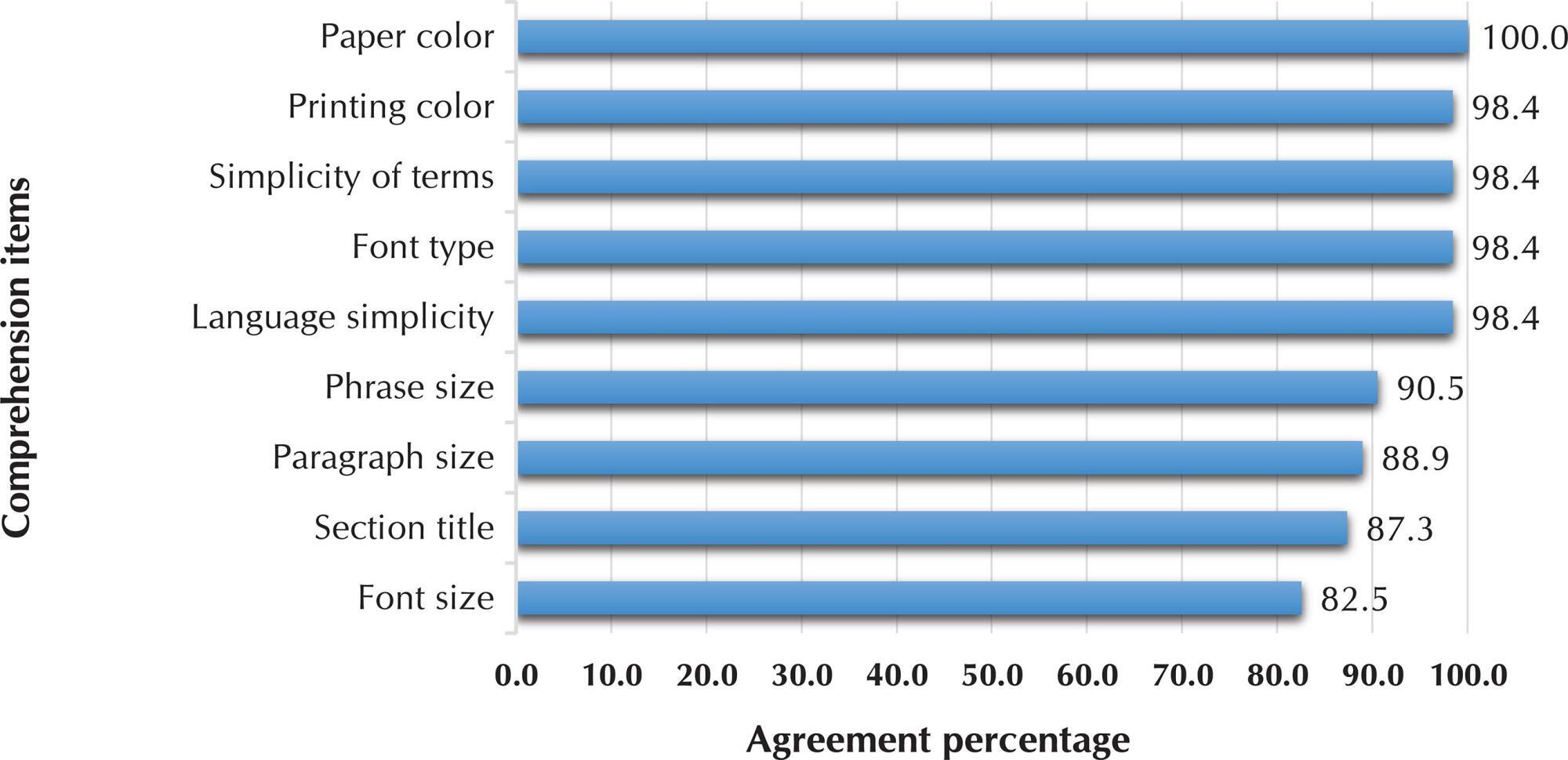
-
PESQUISA01/01/2017
Opioid analgesic administration in patients with suspected drug use
Revista Brasileira de Enfermagem. 2017;70(3):626-632
Resumen
PESQUISAOpioid analgesic administration in patients with suspected drug use
Revista Brasileira de Enfermagem. 2017;70(3):626-632
DOI 10.1590/0034-7167-2016-0501
Visualizações0Ver maisABSTRACT
Objective:
To identify the prevalence of patients suspected of drug use according to the nursing professionals’ judgement, and compare the behavior of these professionals in opioid administration when there is or there is no suspicion that patient is a drug user.
Method:
A cross-sectional study with 507 patients and 199 nursing professionals responsible for administering drugs to these patients. The Chi-Square test, Fisher’s Exact and a significance level of 5% were used for the analyzes.
Results:
The prevalence of suspected patients was 6.7%. The prevalence ratio of administration of opioid analgesics ‘if necessary’ is twice higher among patients suspected of drug use compared to patients not suspected of drug use (p = 0.037).
Conclusion:
The prevalence of patients suspected of drug use was similar to that of studies performed in emergency departments. Patients suspected of drug use receive more opioids than patients not suspected of drug use.

-
PESQUISA01/01/2017
Insulin therapy waste produced in the households of people with diabetes monitored in Primary Care
Revista Brasileira de Enfermagem. 2017;70(3):618-625
Resumen
PESQUISAInsulin therapy waste produced in the households of people with diabetes monitored in Primary Care
Revista Brasileira de Enfermagem. 2017;70(3):618-625
DOI 10.1590/0034-7167-2016-0406
Visualizações0Ver maisABSTRACT
Objective:
To analyze the insulin therapy waste disposal produced in the households of people with diabetes mellitus (DM).
Method:
Cross-sectional study with 105 Primary Care patients. Socio-demographic and clinical variables and insulin therapy practice were analyzed through the absolute and relative frequencies, Fisher’s exact test and prevalence ratio (PR).
Results:
The association between types of insulin (60.0%), administered with a disposable syringe attached to a needle (80.9%), and a high percentage of reuse and disposal in normal household waste (57.1%) stood out. The professionals who most frequently provided guidance to people with diabetes were the nurses. Patients who had received instructions about disposal were 21 times more likely to dispose of waste properly than those who had not (PR 21.5; P < 0.0001). Age, gender, skin color, education, marital status, occupational status and type of DM did not interfere in the disposal (P > 0.05).
-
PESQUISA01/01/2017
Use of the Diffusion of Innovation Model in venous ulcers by specialized professionals
Revista Brasileira de Enfermagem. 2017;70(3):610-617
Resumen
PESQUISAUse of the Diffusion of Innovation Model in venous ulcers by specialized professionals
Revista Brasileira de Enfermagem. 2017;70(3):610-617
DOI 10.1590/0034-7167-2016-0235
Visualizações0Ver maisABSTRACT
Objective:
To analyze the influence of the evidence and of the opinion of peers on the decisions of specialists regarding the agreement with recommendations for prevention and treatment of venous ulcer.
Methods:
This is a quasi-experimental study with two interventions: provision of studies with the evidence of the recommendations and provision of the opinion of peers, with sample of 73 specialized doctors and nurses. Delphi technique was used in the search for agreement, with three rounds.
Results:
The participants evaluated 82 recommendations organized into eight domains: evaluation of patient and wound; documentation of clinical findings; care with the wound and surrounding skin; indication of dressing; use of antibiotics; improvement of venous return and prevention of recurrence; referrals of patients; and professional training. The interventions resulted in statistically significant changes in four domains.
Conclusion:
The interventions were able to change the opinion of participants, leading them to agreement regarding the recommendations, regardless of the level of evidence.
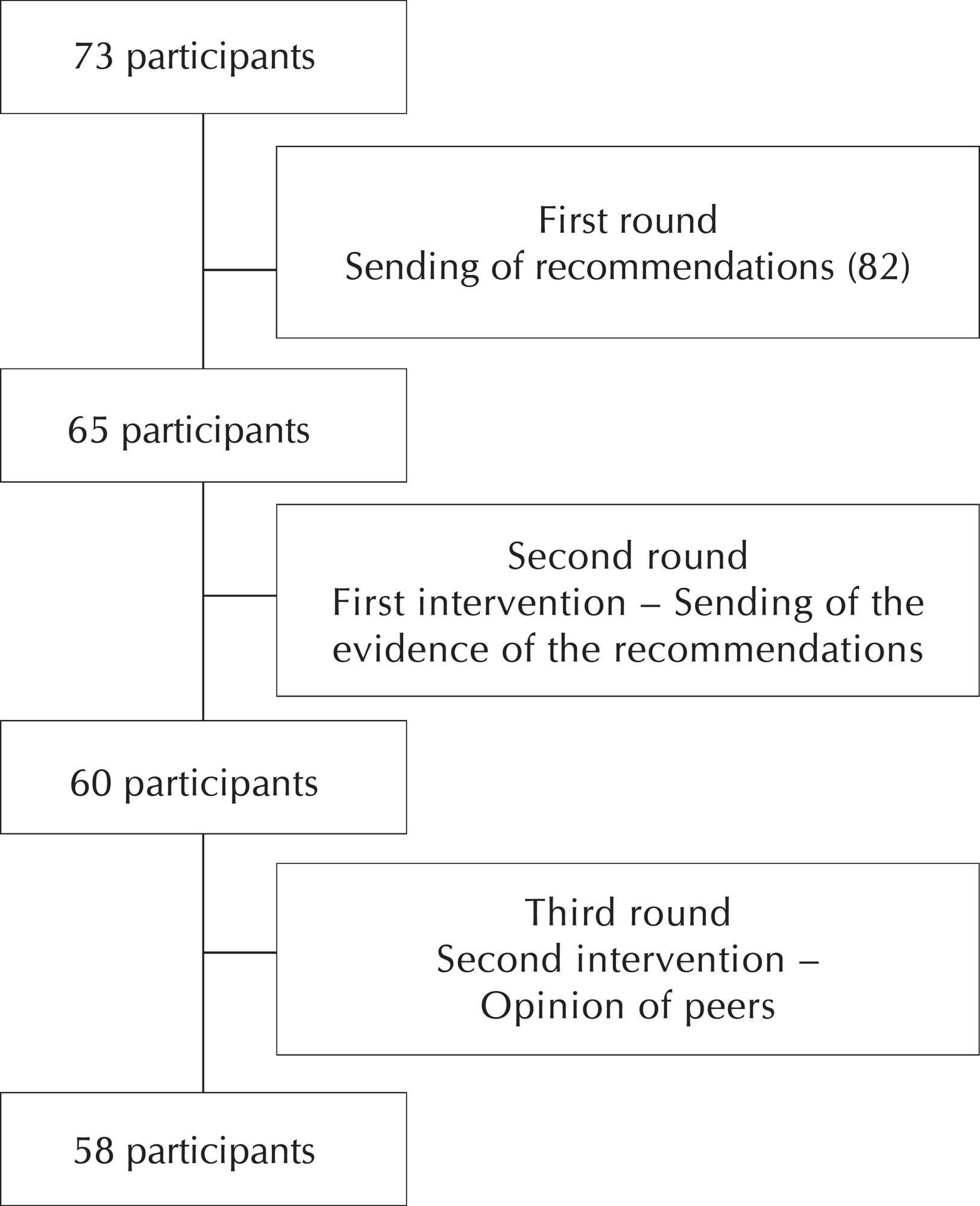
-
PESQUISA01/01/2017
Teaching-learning evaluation on the ICNP® using virtual learning environment
Revista Brasileira de Enfermagem. 2017;70(3):602-609
Resumen
PESQUISATeaching-learning evaluation on the ICNP® using virtual learning environment
Revista Brasileira de Enfermagem. 2017;70(3):602-609
DOI 10.1590/0034-7167-2016-0545
Visualizações0Ver maisABSTRACT
Objective:
Evaluating the teaching-learning process of undergraduates and nursing professionals on the International Classification for Nursing Practice (ICNP®) through a course on Moodle Platform.
Method:
Mixed research conducted with 51 nursing students and nurses. Many technological and educational resources were used. To collect data, two semi-structured questionnaires were applied and focus groups were carried out. Statistical and thematic analysis of the data was performed.
Results:
There was a correlation between the Wiki variable, the Animation Video (p = 0.002) and the Arch Method (p = 0.04), as well as a correlation between the Forum, the Virtual Book (P < 0.001) and time (p = 0.009). Three topics emerged: innovation in the application of technological resources, distance education in the professional education and permanent education and the teaching-learning process on the ICNP® in a collaborative way.
Conclusion:
Teaching-learning strategies and technological resources used were pointed out as innovative and helped students have a better performance.
-
PESQUISA01/01/2017
Use of technologies in intravenous therapy: contributions to a safer practice
Revista Brasileira de Enfermagem. 2017;70(3):595-601
Resumen
PESQUISAUse of technologies in intravenous therapy: contributions to a safer practice
Revista Brasileira de Enfermagem. 2017;70(3):595-601
DOI 10.1590/0034-7167-2016-0216
Visualizações0Ver maisABSTRACT
Objectives:
To identify what are the difficulties of the nursing staff in the management of technologies during intravenous therapy (IVT) and discuss the difficulties identified under the perspective of patient’s safety.
Method:
Descriptive study of qualitative approach with data collected by semi-structured interview and analyzed by the Alceste software.
Results:
The greatest difficulty of cognitive and technical emphasis was the lack of training; and regarding administrative emphasis, the greatest difficulty was the lack of material and human resources. Infusion pumps and their proper use were highlighted as the technological resource that most contributed to patient safety.
Final considerations:
The lack of training is presented as the greatest difficulty of nursing professionals and permeates safety issues of both patient and professional when using the hard technologies in IVT. Training is essential to the development of techniques, considered nursing tools.
-
PESQUISA01/01/2017
Validation of the self-assessment of communication skills and professionalism for nurses
Revista Brasileira de Enfermagem. 2017;70(3):588-594
Resumen
PESQUISAValidation of the self-assessment of communication skills and professionalism for nurses
Revista Brasileira de Enfermagem. 2017;70(3):588-594
DOI 10.1590/0034-7167-2016-0133
Visualizações0Ver maisABSTRACT
Objectives:
to translate, adapt cross-culturally and validate into Brazilian Portuguese the following instrument: «Self-assessment of communication skills and professionalism in residents» for the nursing professional, and to determine if personal characteristics and performance of the nurse interfere in the self-assessment about professionalism and interpersonal communication.
Method:
quantitative study.
Results:
the sample consisted of 110 nurses with mean age of 32 years old (± 7.3), most of them were women (n = 80; 72.7%). The internal consistency of the scale «Autoavaliação sobre profissionalismo e comunicação interpessoal entre enfermeiro e paciente» presented moderate and satisfactory reliability (α=0,712). Factorial analysis identified four factors: Interpersonal Skills, Exchange of Information, Honesty in the Relationship and Professionalism.
Conclusion:
the instrument is valid and reliable in Portuguese and for Brazilian culture. Interpersonal Skills changed with gender and marital status. Ability to exchange information was influenced by gender and working sector. Self-assessment of professionalism changed with marital status.
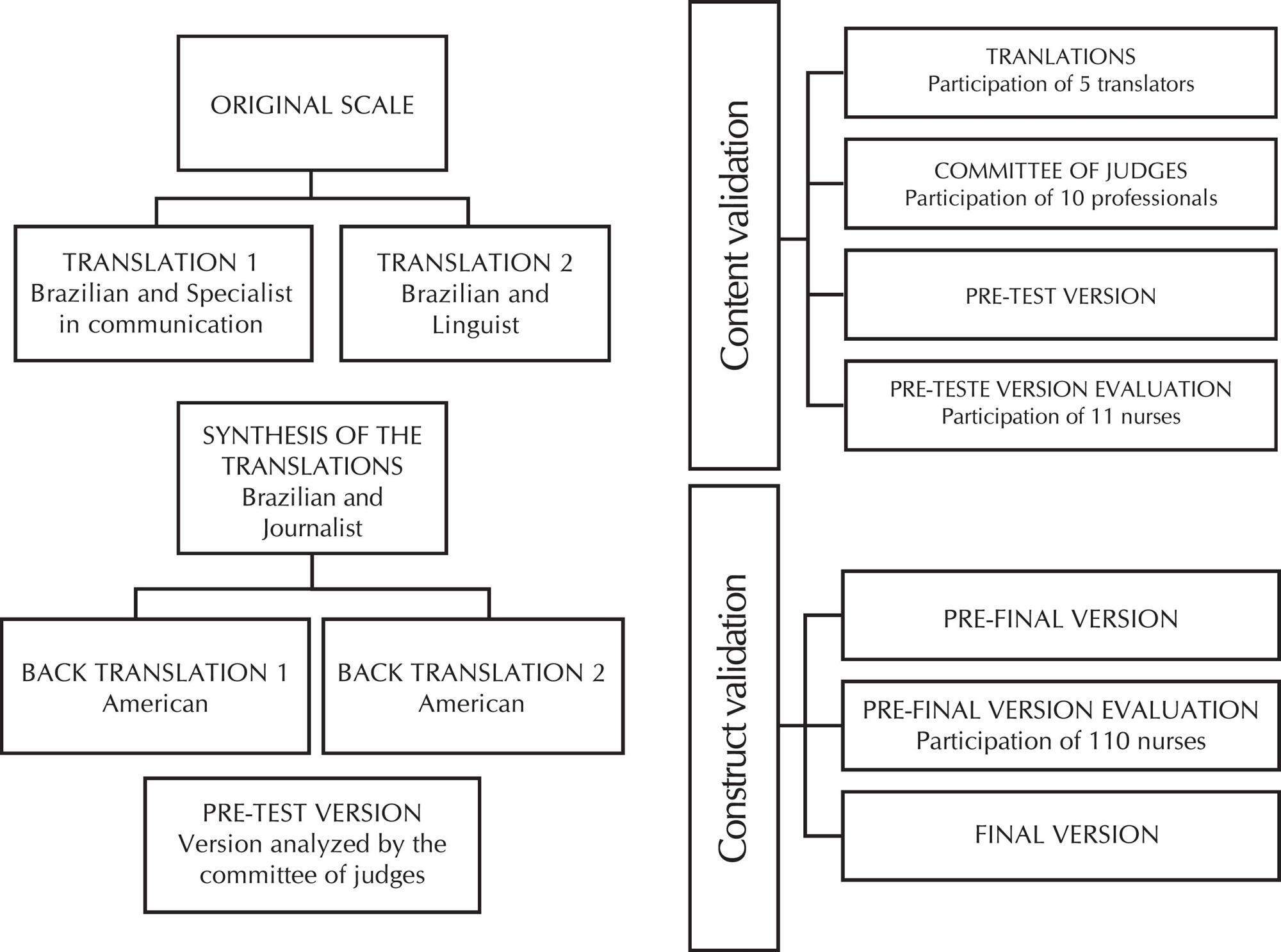
-
PESQUISA01/01/2017
Power relations in the family health team: focus on nursing
Revista Brasileira de Enfermagem. 2017;70(3):580-587
Resumen
PESQUISAPower relations in the family health team: focus on nursing
Revista Brasileira de Enfermagem. 2017;70(3):580-587
DOI 10.1590/0034-7167-2015-0171
Visualizações0Ver maisABSTRACT
Objective:
to analyze the power relations that permeate the work of the family health team, and to discuss perspectives of emancipation of these subjects, focusing on nursing and community health agents.
Method:
a qualitative study with a family health team from a municipality in the countryside of the state of São Paulo. Data were collected through systematic observation and interview with workers. A thematic content analysis was performed.
Results:
three categories were identified: the work of the family health team and power relations; power relations between the nurse and the healthcare team; and the relations among the nursing team and between community agents and the nurse. The team produces relations of power moved by hierarchical knowledge that move in the search for the reordering of powers.
Final considerations:
it is necessary to review the contradictions present in the performance scenario of the family health teams, with a view toward making power relations more flexible.
-
14/04/2021
Child behavior during the social distancing in the COVID-19 pandemic
Revista Brasileira de Enfermagem. 2021;74:e20200762
Resumen
Child behavior during the social distancing in the COVID-19 pandemic
Revista Brasileira de Enfermagem. 2021;74:e20200762
DOI 10.1590/0034-7167-2020-0762
Visualizações0Ver maisABSTRACT
Objective:
To describe the daily activities performed by children from 6 to 12 years of age incomplete and analyze children’s behavior during social distancing in the face of the COVID-19 pandemic.
Methods:
Cross-sectional study with children in a learning stage living in Brazil. The data were collected via online form. Fisher’s exact test was applied to analyze the association of categorical variables with child behavior; when significant, it was used the odds ratio. It was considered results considered statistically significant those presenting values of p < 0.05.
Results:
Data from 530 children were analyzed: 50.3% female, 71.3% from the Southeast Region, 73% in fulltime social distancing, 52% presented anxiety, which was significantly associated with changes in sleep and appetite.
Conclusion:
The results indicate the need for parents/caretakers to stimulate moments for the child to express themselves, not minimizing their feelings and providing emotional support to mitigate the negative impact of these feelings on the child’s mental and physical health.
-
05/12/2019
Hospital care and urinary incontinence in the elderly
Revista Brasileira de Enfermagem. 2019;72:284-293
Resumen
Hospital care and urinary incontinence in the elderly
Revista Brasileira de Enfermagem. 2019;72:284-293
DOI 10.1590/0034-7167-2018-0273
Visualizações0Ver maisABSTRACT
Objective:
to identify factors inherent in hospital care that favor urinary incontinence in the elderly.
Method:
an integrative review with Scopus, CINAHL and Pubmed searches. Includes original articles, no language restriction, published between 2008 and 2018. Rated level of recommendation and level of evidence were assessed using the Oxford Center for Evidence-Based Medicine classification. Exploited content through thematic analysis in light of the Donabedian model.
Results:
13 articles constituted the sample. There were factors such as the unjustified and indiscriminate use of devices such as the geriatric diaper; hospital structure adversely affecting the needs of the elderly; and deficit in screening, risk identification and underreporting of the problem favor urinary incontinence in the hospitalized elderly.
Conclusion:
modifiable factors related to hospital structures and care processes favor both the onset and worsening of urinary incontinence in the elderly.
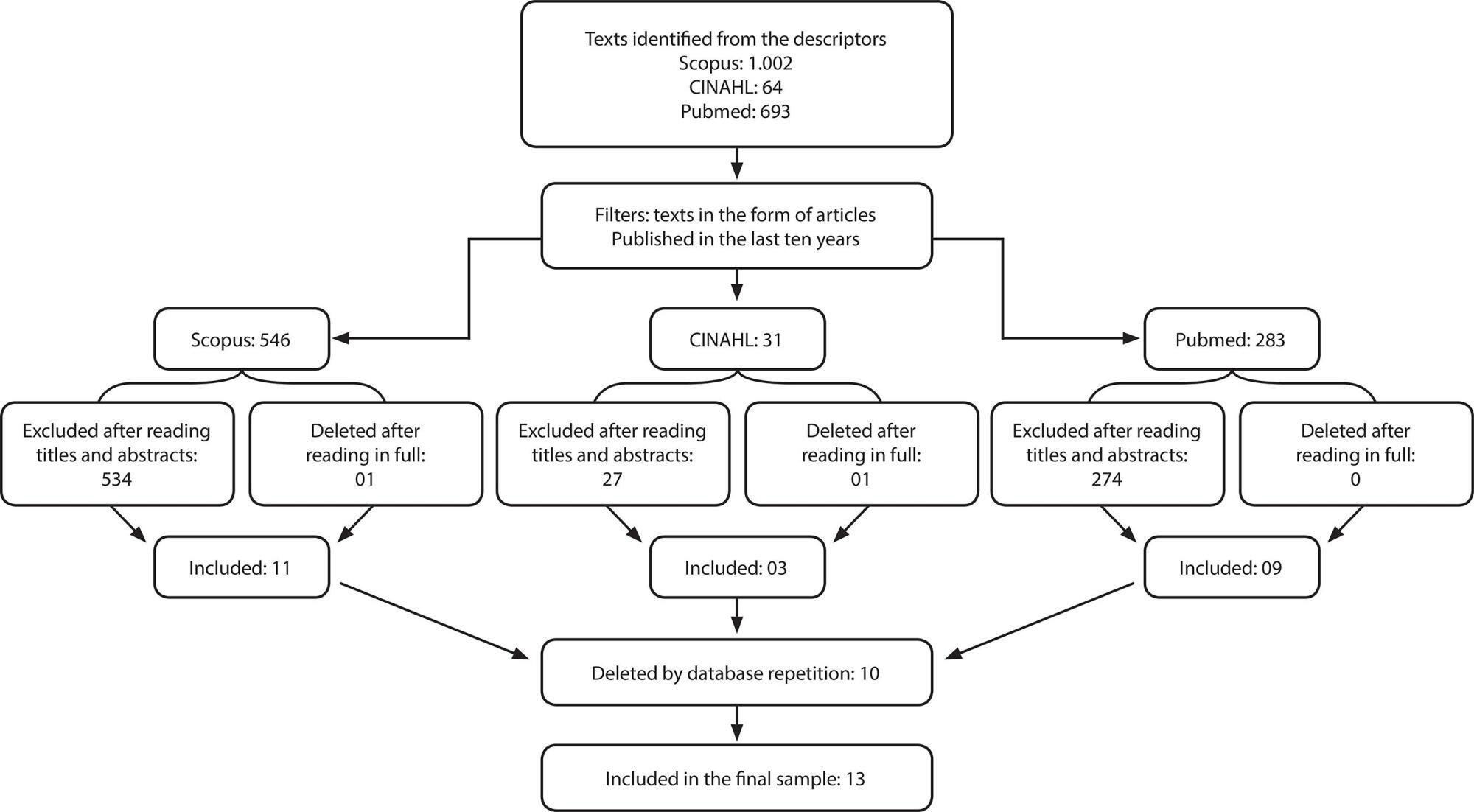
-
ARTÍCULO ORIGINAL21/10/2019
Hipermídia educativa sobre assistência de enfermagem ao parto: construção e validação de conteúdo e aparência
Revista Brasileira de Enfermagem. 2019;72(6):1471-1478
Resumen
ARTÍCULO ORIGINALHipermídia educativa sobre assistência de enfermagem ao parto: construção e validação de conteúdo e aparência
Revista Brasileira de Enfermagem. 2019;72(6):1471-1478
DOI 10.1590/0034-7167/2018-0163
Visualizações1Ver maisRESUMO
Objetivo:
construir uma hipermídia educativa sobre a assistência de enfermagem ao parto de risco habitual e realizar a validação de conteúdo e de aparência.
Método:
pesquisa metodológica, realizada seguindo as seguintes etapas: levantamento do conteúdo e planejamento dos módulos; produção das mídias e organização das unidades tutoriais; organização do espaço do aluno, tutor e de comunicação entre eles; elaboração da hipermídia; disponibilização da hipermídia; avaliação por especialistas em Enfermagem e Informática; e implementação das sugestões propostas.
Resultados:
a hipermídia educativa mostrou-se como um material validado, visto que apresentou um ótimo índice de validade de conteúdo global de 0,97 e significância estatística no teste binomial para o conteúdo e aparência.
Conclusão:
acredita-se que o uso deste material com alunos da graduação em Enfermagem contribuirá com a qualidade da assistência obstétrica, tendo em vista que se constitui em uma tecnologia ilustrada capaz de favorecer o ensino-aprendizagem sobre parto normal humanizado.
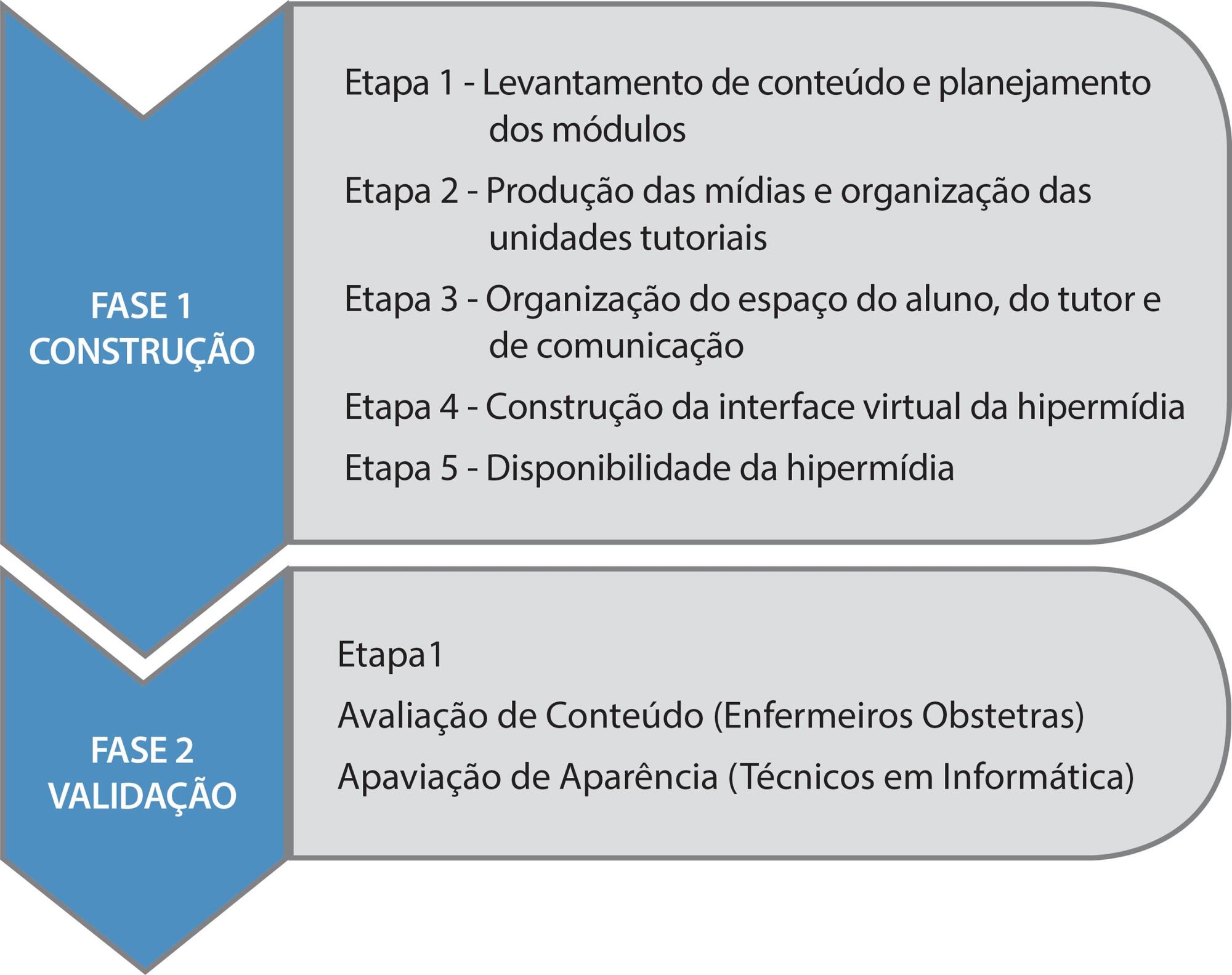
-
ARTÍCULO ORIGINAL30/03/2020
Boas Práticas de segurança nos cuidados de enfermagem em Terapia Intensiva Neonatal
Revista Brasileira de Enfermagem. 2020;73(2):e20180482
Resumen
ARTÍCULO ORIGINALBoas Práticas de segurança nos cuidados de enfermagem em Terapia Intensiva Neonatal
Revista Brasileira de Enfermagem. 2020;73(2):e20180482
DOI 10.1590/0034-7167-2018-0482
Visualizações0RESUMO
Objetivos:
identificar a percepção dos profissionais de enfermagem sobre o erro humano nos cuidados de enfermagem na Unidade de Terapia Intensiva Neonatal; analisar as estratégias de Boas Práticas propostas por esses profissionais para a segurança do paciente nos cuidados de enfermagem.
Métodos:
estudo quanti-qualitativo, descritivo. Cenário: Unidade de Terapia Intensiva Neonatal. Participantes: 22 profissionais de enfermagem. Coleta dos dados realizada por meio de entrevistas e submetidos a análise temática.
Resultados:
erro humano nos cuidados de enfermagem, identificando-se perdas de cateteres e erros no processo de medicação; causas para o erro nos cuidados de enfermagem, destacando-se a sobrecarga de trabalho; Boas Práticas para a segurança do paciente nos cuidados de enfermagem, como capacitação profissional e melhorias das condições de trabalho.
Conclusões:
demonstra-se a importância de investir em estratégias de Boas Práticas para a Segurança do Paciente, buscando-se sedimentar a cultura de segurança organizacional e estimular um ambiente propício ao gerenciamento do erro.
Palavras-chave: EnfermagemErros MédicosGestão de SegurançaSegurança do PacienteUnidades de Terapia Intensiva NeonatalVer mais -
ARTÍCULO DE REVISIÓN29/09/2022
Nursing students’ learning from involvement in research projects: an integrative literature review
Revista Brasileira de Enfermagem. 2022;75(1):e20210053
Resumen
ARTÍCULO DE REVISIÓNNursing students’ learning from involvement in research projects: an integrative literature review
Revista Brasileira de Enfermagem. 2022;75(1):e20210053
DOI 10.1590/0034-7167-2021-0053
Visualizações0Ver maisABSTRACT
Objective:
To identify the learning outcomes and skills obtained of undergraduate nursing students involved in research projects.
Methods:
This was an integrative literature review, based on a research protocol in the CINAHL Complete databases; Cochrane Central Register of Controlled Trials; Cochrane Database of Systematic Reviews; Cochrane Methodology Register; MedicLatina; MEDLINE, Scopus and JBI, including primary and secondary studies, published between 2015 and 2020.
Results:
A total of five heterogeneous articles were included, which were categorized using Kirkpatrick’s (adapted) model. Seventeen learning outcomes acquired through participation in research projects were identified, from the learning of new knowledge and skills to the development of new attitudes and behaviors.
Final considerations:
The involvement of nursing students in research projects is important to their professional development. Future investment in research on this topic can help cement the potential of this type of student involvement.
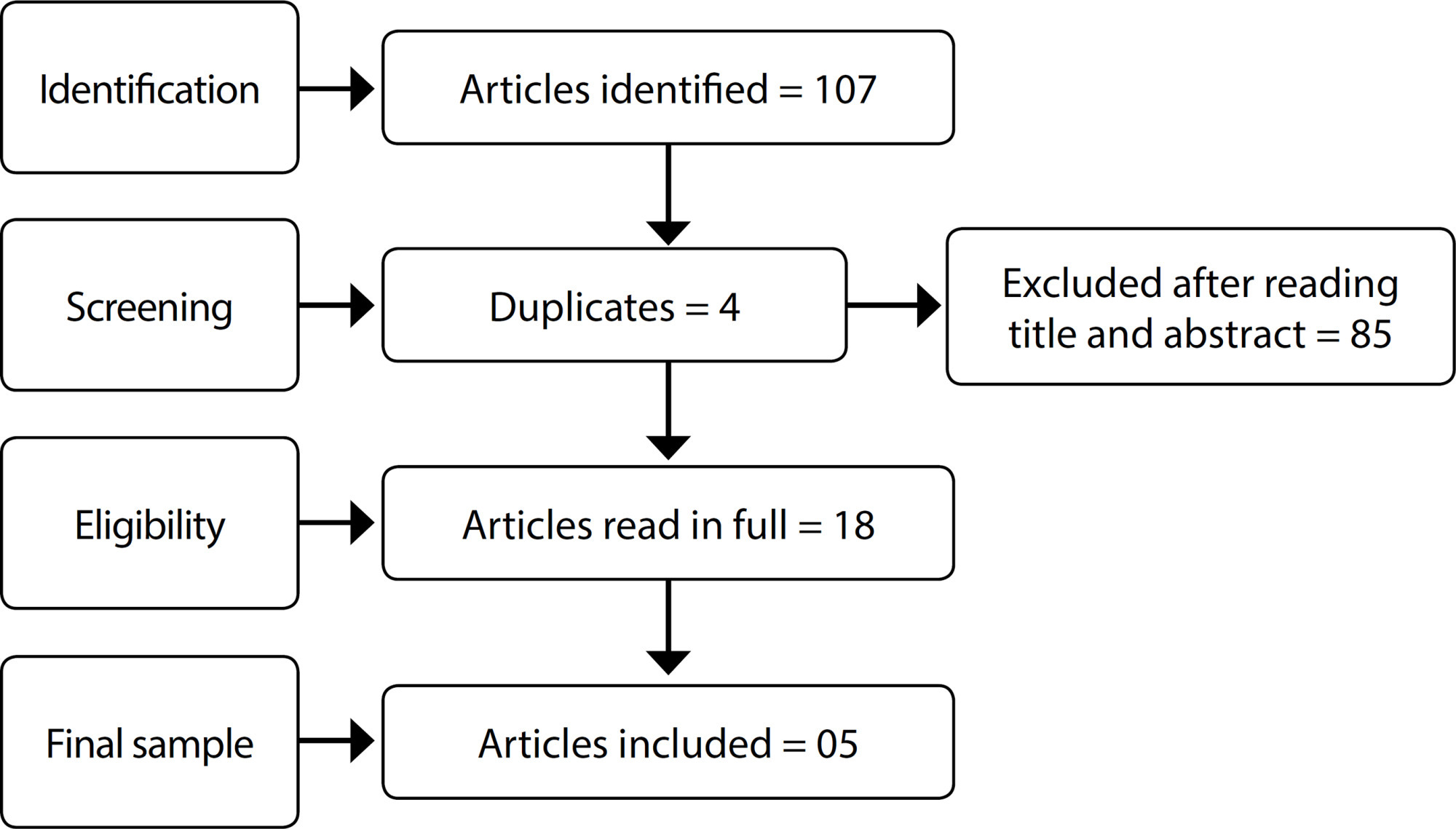
-
ARTÍCULO ORIGINAL05/12/2019
Qualidade de vida relacionada à saúde em pacientes com insuficiência cardíaca
Revista Brasileira de Enfermagem. 2019;72:140-146
Resumen
ARTÍCULO ORIGINALQualidade de vida relacionada à saúde em pacientes com insuficiência cardíaca
Revista Brasileira de Enfermagem. 2019;72:140-146
DOI 10.1590/0034-7167-2018-0368
Visualizações1RESUMO
Objetivo:
Avaliar a qualidade de vida relacionada à saúde dos pacientes com insuficiência cardíaca e relacionar aos dados sociodemográficos e clínicos.
Método:
Trata-se de estudo observacional, de corte transversal, com abordagem quantitativa realizado em ambulatório de insuficiência cardíaca no estado de Pernambuco.
Resultados:
Na amostra (n=101) houve predominância de homens, maiores de 60 anos, casados, profissionalmente inativos. A qualidade de vida relacionada à saúde, a partir do questionário Minnesota Living With Heart Failure Questionnaire foi considerada moderada (34,3±21,6), apresentando relação significativa com idade (p=0,004), classe funcional (p<0,001) e em pacientes com cardiopatia chagásica (p=0,02).
Conclusão:
A qualidade de vida no grupo IC de etiologia chagásica esteve mais comprometida, especialmente na dimensão emocional. Sugere-se a realização de estudos abordando as hipóteses de que maior tempo de acompanhamento ambulatorial melhora a qualidade de vida e que ter doença de Chagas interfere negativamente na qualidade de vida de pacientes com insuficiência cardíaca.
Palavras-chave: Assistência AmbulatorialDoença de ChagasEnfermagemInsuficiência CardíacaQualidade de VidaVer mais -
ARTÍCULO DE REVISIÓN21/12/2020
Aplicação da metodologia Lean Seis Sigma nos cenários de assistência à saúde: revisão integrativa
Revista Brasileira de Enfermagem. 2020;73:e20190861
Resumen
ARTÍCULO DE REVISIÓNAplicação da metodologia Lean Seis Sigma nos cenários de assistência à saúde: revisão integrativa
Revista Brasileira de Enfermagem. 2020;73:e20190861
DOI 10.1590/0034-7167-2019-0861
Visualizações0RESUMO
Objetivo:
analisar a produção científica sobre os resultados da metodologia Lean Six Sigma nas instituições de assistência à saúde.
Métodos:
revisão integrativa da literatura, com a seguinte pergunta: quais são os resultados nas instituições de saúde com a utilização da metodologia Lean Six Sigma e Six Sigma? A busca foi realizada nas bases de dados MEDLINE, LILACS, BDENF, CINAHL, Web of Science e Scopus, sem recorte temporal.
Resultados:
foram incluídos 34 artigos, publicados entre 2005 e 2019, sendo 52,9% provenientes dos Estados Unidos da América. As melhorias mais comumente encontradas foram em instituições hospitalares e na perspectiva dos clientes e processos internos.
Conclusão:
a utilização da metodologia Lean Six Sigma se demonstrou eficaz nos diversos cenários de assistência à saúde, se destacando uma lacuna em sua aplicação quanto ao engajamento e capacitação de pessoas.
Palavras-chave: Administração em SaúdeAssistência à SaúdeControle de QualidadeGestão da Qualidade TotalMelhoria de QualidadeVer mais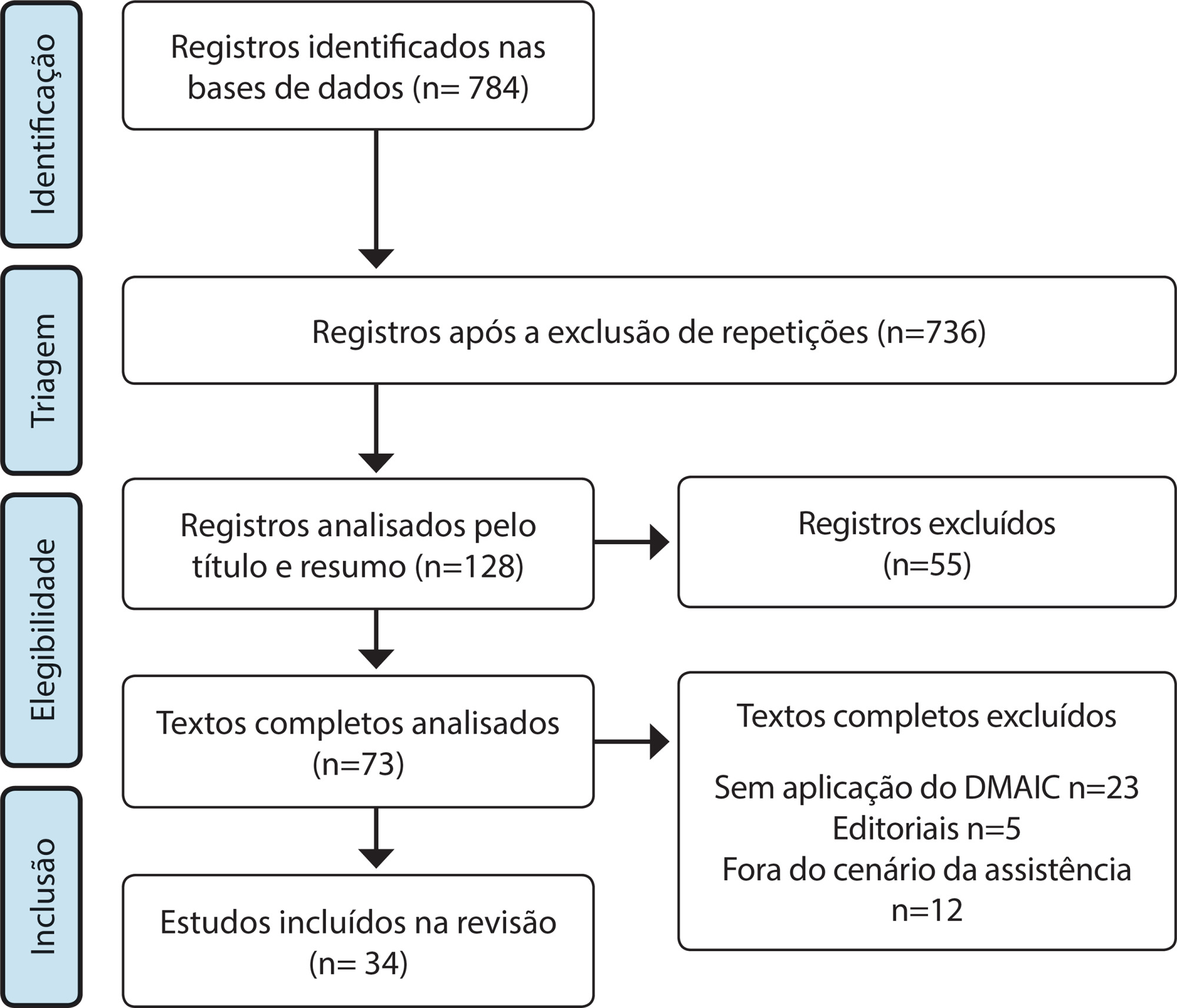
-
ARTÍCULO ORIGINAL17/02/2020
Análise dos registros de técnicos de enfermagem e enfermeiros em prontuários
Revista Brasileira de Enfermagem. 2020;73(2):e20180542
Resumen
ARTÍCULO ORIGINALAnálise dos registros de técnicos de enfermagem e enfermeiros em prontuários
Revista Brasileira de Enfermagem. 2020;73(2):e20180542
DOI 10.1590/0034-7167-2018-0542
Visualizações0RESUMO
Objetivos:
analisar as principais não conformidades dos registros de enfermagem de um hospital público do Nordeste na cidade de Natal.
Métodos:
estudo descritivo, transversal, abordagem quantitativa. Realizado em enfermarias médicas e cirúrgicas. Amostra composta de 120 prontuários de pacientes internados entre outubro e dezembro de 2016. Os dados obtidos foram tabulados e analisados por estatística simples em frequência absoluta e relativa com o software Microsoft Excel 2013. Para avaliar as não conformidades dos registros, usou-se o Diagrama de Pareto.
Resultados:
como principais problemas nos registros de enfermagem, destacou-se a ausência da categoria profissional e número do conselho, responsáveis por 41,8% das não conformidades nos registros de técnicos de enfermagem, enquanto nas anotações dos enfermeiros foram a ausência de hora e as letras ilegíveis, com 61,2%.
Conclusões:
o estudo evidenciou que os profissionais de enfermagem realizam seus registros de forma incompleta e que muitas vezes não documentam o cuidado prestado.
Palavras-chave: ComunicaçãoEnfermagemPesquisa sobre Serviços de SaúdeRegistros de EnfermagemSegurança do PacienteVer mais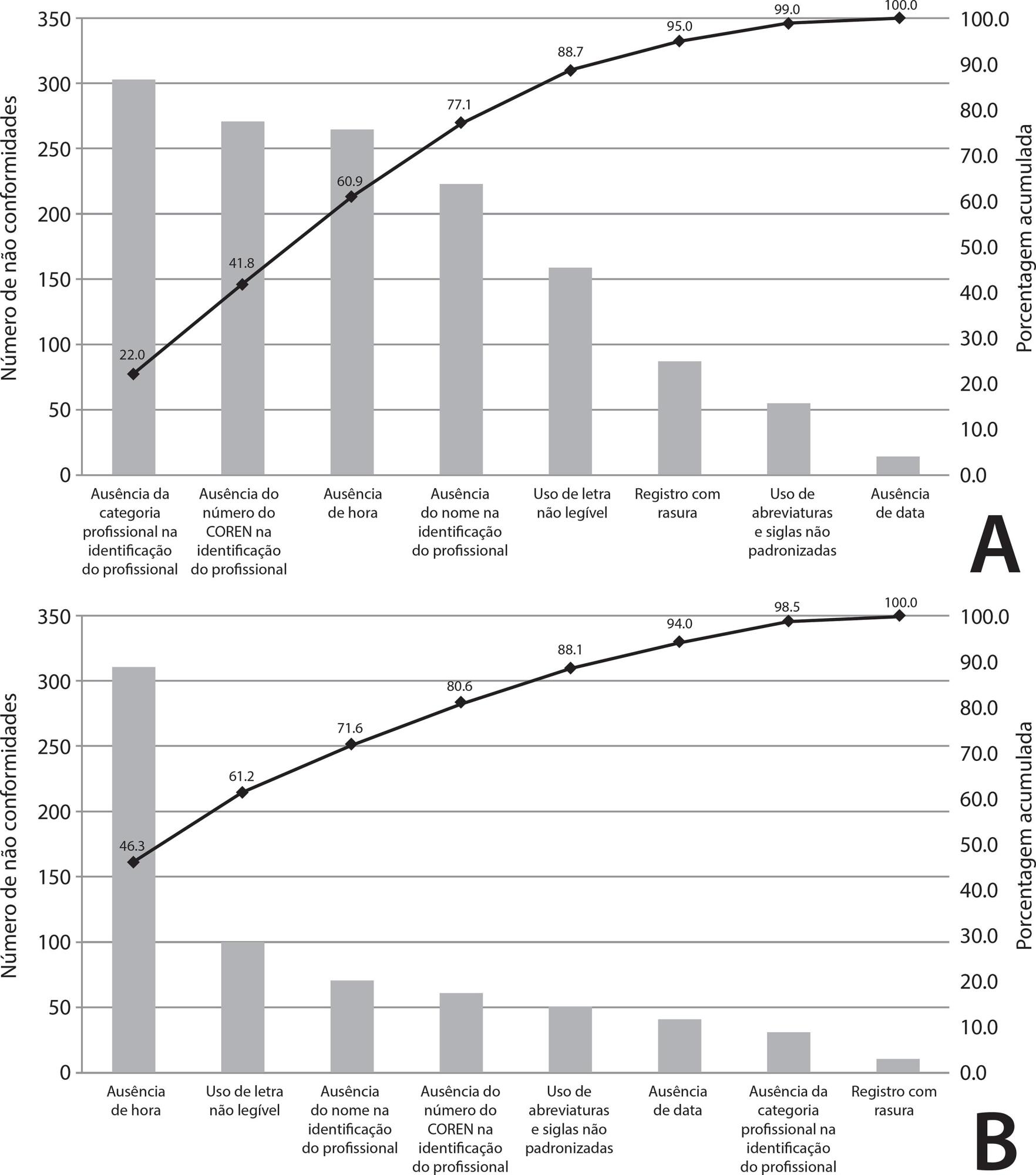
Búsqueda
Buscar en:
Nuvem de Tags
Adolescente (85) Atenção Primária à Saúde (239) COVID-19 (91) Criança (91) Cuidados de Enfermagem (269) Educação em Enfermagem (151) Educação em Saúde (139) Enfermagem (930) Enfermagem Pediátrica (86) Estudantes de Enfermagem (77) Estudos de Validação (131) Família (87) Idoso (208) Promoção da Saúde (99) Qualidade de Vida (104) Saúde do Trabalhador (86) Saúde Mental (145) Saúde Pública (82) Segurança do Paciente (150) Tecnologia Educacional (100)



